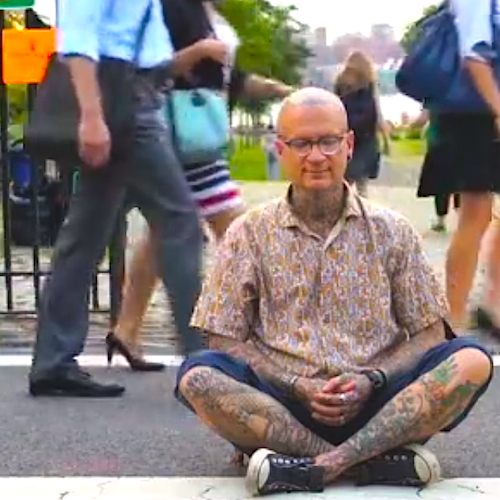It’s hardly news that life is stressful, a journey in which disappointing and emotionally difficult events will occur.
Putting aside the inevitable ordeals of aging and sickness, you and I will experience the loss of loved ones; projects we’ve devoted years of effort towards may suddenly fail; stuff will hit the fan. The world doesn’t conform to our plans; there’s no way to avoid pain and discomfort as the Buddha noted in his first noble truth.
And yet, despite all the bad news you and I will face, our lives could be so peaceful, even joyous, if we didn’t add needless suffering into the mix. What needless suffering?
As the second noble truth suggests, our greatest source of misery is the desire for life to be otherwise, the seeking of an inoculation against discomfort.
We react to bad news as if it’s a mistake, a personal affront, and crave a way to avoid what’s inevitable. For example, Americans will spend over $12 billion this year on face lifts, Botox treatments and breast augmentations. The more we struggle against the inevitable, the more prone we become to repetitive thought patterns.
Of course, chronic stress and worry transcends how we react to aging. It’s a pattern installed by evolution: When our ancestors experienced a looming danger, those that became anxious probably reacted and lived to face another day, while those that remained peacefully unaware, and didn’t feel motivated to act, probably perished.
50,000 years ago, living on the Serengeti, a state of “high alert” that resulted during a life threatening encounter increased ours chances of survival (the heart races and pumps blood to the outer limbs, allowing us to fight harder or run faster, the digestive system halts, we stop producing the white blood cells that aid our immune response while creating excessive red blood cells, as the body prepares itself for physical injury).
Today life is a bit different. While our hardwired reactions and negative emotions—anger, anxiety, etc.—are appropriate when those rare, life threatening situations occur, for most of us having a hair trigger stress response is unnecessary.
We are the dominant species on the planet, after all. Anxiety is more than an unpleasant sensation—stress hormones, such as cortisol, which run through the body for long periods, take a disastrous toll on our health.
Stress that continues without regular deactivation becomes chronic stress, which leads to all kinds of problems: stomach ailments, high blood pressure, insomnia, hair loss, headaches, heart problems, the list goes on and on. Our immune systems suffer due to the reduction of white blood cells and overproduction of red blood cells. Stress also leads to a greater dependence on, or addiction to, mood changing behaviors such as alcohol, drugs, shopping, food binges, etc., as a means to relieve this underlying tension.
Alas, in our busy lives, when we deal with a stressful situation, we often move directly to the next challenge, then to the next, stumbling across even more stressors—our smartphones and laptops push texts and emails at us that ask for our immediate attention, the viral posts on news feeds are invariably grim.
And so it’s easy to overlook the importance of taking time to deactivate ourselves from “high alert” states. But if we overlook taking time to restore the body to a neutral state, chronic stress builds, and it becomes progressively harder to override anxiety; stress becomes chronic.
It’s important to note that so long as we remember to switch off our stress activations when the external demand has been met, the long term effects of stress aren’t particularly adverse. Unfortunately, many of us never learn how to “switch off.”
And so I’d like to offer a routine I employed to stay sane and peaceful while I worked as an advertising art director and copywriter (my livelihood before I became a dharma teacher). Now, you might object that advertising is hardly an industry known for its life threatening experiences, but let me assure you, the impossible deadlines, difficult to please clients, long work days and exacting standards provided a ceaseless array of stressors and triggers.
Over the years in busy offices many colleagues developed panic attacks, anxiety disorders and other stress-induced maladies. And so, for my own peace of mind, I practied a “Ninety Second Sanity Pit Stop.” Here’s how it goes.
Take the first pause or break available:
When caught up in the narratives and dramas that trigger us—when we find ourselves “putting out one fire after another at work,” our foot on life’s gas pedal, impatient to the point of honking at others, etc.—the first step is to divert our attention from the visual and audio sensations that agitate us, such as the conversation or the computer screen. Sometimes we’ll have to remind ourselves that a 90 second mental health break will not change the outcome, unless we’re about to be trampled by wild animals, in which case continue running.
The first 30 seconds:
Become aware of your out breath and extend each exhalation as long and smooth as possible, until they’re at least three times as long as each in breath. Long out breaths activate the vagus nerve which, in turn, “switch on” the parasympathetic nervous system, deactivating the stress response. Don’t worry about your in breath, as your body knows how much oxygen to take in.
The second 30 seconds:
Find the muscle groups in your body that are most constricted and use each out breath to release and relax the tension. I highly recommend focusing on the areas where somatic emotions register, such as the abdominal muscles (fear), shoulders (feeling overwhelmed), the chest (abandonment) and the micro-muscles around the eyes (just about every emotion). Sometimes it helps to lightly tighten the muscles with the in breath, so that we can have a greater release during the exhalations.
The last 30 seconds:
While keeping the breath in awareness, bring an image of yourself onto the mind’s inner movie screen, where fantasies and memories play out. Holding the image, direct thoughts of kindness and compassion towards it: “May I be truly at ease.” “May I find lasting peace.” “I love you, keep going,” etc.
These thoughts can be repeated with every out breath, or again and again so other thoughts don’t intrude. When the 90 seconds are up, slowly open your eyes, and try, as you return to the busy stimuli of life, to keep some awareness on those outbreaths.
I recommend setting a timer on a smart phone or computer to remind us to take a pit stop every two hours at the very least; think of it as a spiritual refueling. I’ve used this tried-and-true method for quite a long time; it’s how I survived working in industries where other people succumbed to many stress related setbacks. I hope it will help others in their journeys.
~
Love elephant and want to go steady?
Sign up for our (curated) daily and weekly newsletters!
Author: Josh Korda
Editor: Travis May
Photo: Author’s Own
Ready to join?
Hey, thanks so much for reading! Elephant offers 1 article every month for free.
If you want more, grab a subscription for unlimited reads for $5/year (normally, it's $108/year, and the discount ends soon).
And clearly you appreciate mindfulness with a sense of humor and integrity! Why not join the Elephant community, become an Elephriend?
Your investment will help Elephant Journal invest in our editors and writers who promote your values to create the change you want to see in your world!
Already have an account? Log in.
Ready to join?
Hey, thanks so much for reading! Elephant offers 1 article every month for free.
If you want more, grab a subscription for unlimited reads for $5/year (normally, it's $108/year, and the discount ends soon).
And clearly you appreciate mindfulness with a sense of humor and integrity! Why not join the Elephant community, become an Elephriend?
Your investment will help Elephant Journal invest in our editors and writers who promote your values to create the change you want to see in your world!
Already have an account? Log in.
Ready to join?
Hey, thanks so much for reading! Elephant offers 1 article every month for free.
If you want more, grab a subscription for unlimited reads for $5/year (normally, it's $108/year, and the discount ends soon).
And clearly you appreciate mindfulness with a sense of humor and integrity! Why not join the Elephant community, become an Elephriend?
Your investment will help Elephant Journal invest in our editors and writers who promote your values to create the change you want to see in your world!
Already have an account? Log in.
 Share on bsky
Share on bsky





Read 3 comments and reply